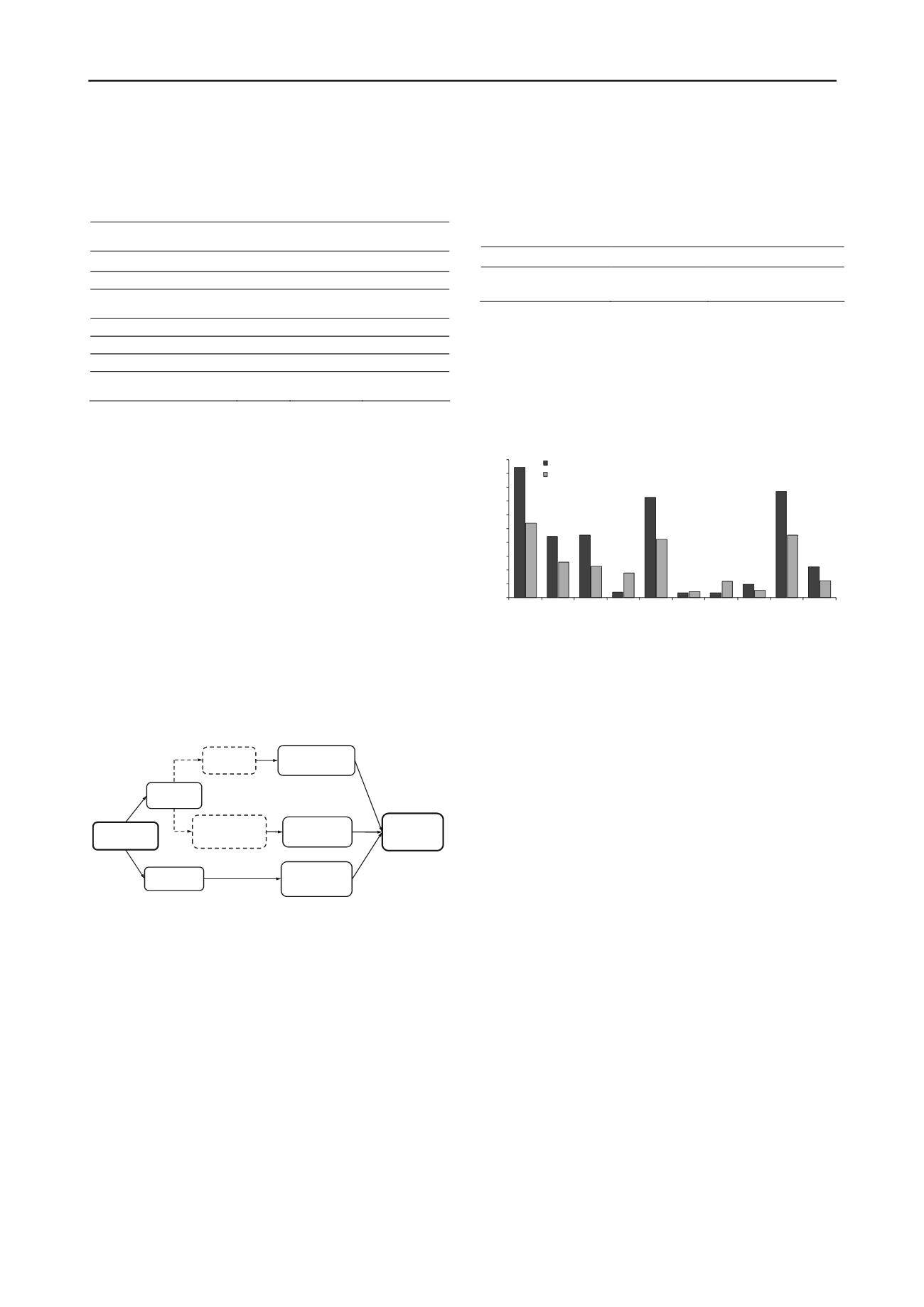
3161
Technical Committee 307 /
Comité technique 307
geosynthetics manufacturing is mostly controlled by the impacts
of raw-material production and electricity consumption during
manufacturing.
Table 1. Selected key figures describing the constructions of one square
eter of gravel and geosynthetics filter (Table 2 of Frischknecht et al.).
m
Material/Process
Unit
Gravel
filter
Geosynthetics
filter
Gravel
t/m
2
0.69
0
Geosynthetics layer
m
2
/m
2
0
1
Diesel used in
building machines
MJ/m
2
2.04
1.04
Transport, lorry
tkm/m
2
34.5
0.035
Transport, freight, rail
tkm/m
2
0
0.07
Particulates > 10 µm
g/m
2
4.8
0
Particulates > 2.5 µm
and < 10 µm
g/m
2
1.3
0
Holm et al. developed an assessment and decision making
tool for sustainable management of contaminated sediments in
the Baltic sea, which included an emerging technology of
solidification/stabilization. They presented the results of three
case studies based on the ports of Oxelösund (Sweden), Gävle
(Sweden) and Hamburg (Germany). Different management
scenarios were considered at each port, and LCA were
performed to choose the best options. Recycling of sediments,
disposal in river and sea, energy use, and environmental impact
were considered in the LCA. Holm et al. further developed a
multicriteria decision analysis (MCDA) to integrate the three Es
of sustainability in their decision making tool following a
structured and balanced way.
Basu et al. also developed a multicriteria based sustainability
assessment framework and applied it to pile foundation projects.
The framework considers a life-cycle view of the pile
construction process, and combines resource consumption,
environmental impact, and socio-economic benefits of a pile-
foundation project over its entire life span to develop a
sustainability index (Figure 12).
Figure 12. Multicriteria based sustainability assessment framework
(Figure 3 of Basu et al.).
Edil provided an overview of the sustainability assessment
tools used in pavement construction projects. He mentioned that
LCA and life cycle cost analysis (LCCA) can be successfully
used to assess the sustainability of pavement constructions. He
further described a rating system for sustainable highway
constructions known as Building Environmentally and
Economically
Sustainable
Transportation-Infrastructure-
Highways (BE
2
ST-in-Highways
TM
), which evaluates the
sustainability of a highway project in terms of quantitative
difference between a reference design and proposed alternative
designs.
Farias et al. performed an economic analysis of different
construction alternatives for their CDW paving project
described in section 3.1. Although this is not a complete
sustainability analysis, the environmental and social benefits are
inherently present in the project. They considered two
alternatives, first in which the CDW is completely disposed of
in landfills and second in which the CDW and in situ soil
mixture is used in paving the construction site. The high cost of
disposal (Table 2) made the first option the most viable one with
a direct cost savings of US$ 1.9 million, which does not even
include the indirect cost-saving benefits from the reduced
environmental impact that the project ensures.
Table 2. Costs for final disposition of wastes in licensed places (Table 6
of Farais et al.).
Disposition place
Unit
Unitary cost (US$)
Inert landfill
m
3
47.30
Processing plant
m
3
18.36
* Transportation cost not considered
In their study on the use of enzymatic solution and
lignosulfonate as additives in silt (described in section 3.1),
Blanck et al. performed LCA-EIA using 10 impact categories
proposed in the NF P 01-010 standard. The analysis showed that
the use of enzymatic solution reduces impacts in seven out of
ten categories (Figure 13). The use of lignosulfate, however, did
not produce sufficient environmental benefits.
18,8
8,9
9,1
0,8
14,5
0,7
0,7
2,0
15,3
4,4
10,7
5,1
4,6
3,6
8,4
0,9
2,3
1,1
9,0
2,5
0
2
4
6
8
10
12
14
16
18
20
Valeur de l'indicateur
Catégorie d'impact
Non traité
0,002% produit enzymatique
Consommation de
ressources énergétiques
(x 10
3
MJ)
Epuisement de
ressources naturelles
(kg éq. Sb)
Consommation d'eau
(x 10
4
L)
Productionde déchets
solides (kg)
Changement climatique
(x 10
2
kg éq. CO
2
)
Acidification
atmosphérique
(kg éq. SO
2
)
Destructionde l'ozone
statosphérique
(x 10
-5
kgéq. SO
2
)
Formation d'ozone
atmosphérique
(kgéq. éthylène)
Pollution de l'air
(x 10
4
m
3
)
Pollution de l'eau
(x 10
2
m
3
)
Figure 13. Results of environmental impact analysis for the use of
enzymatic solution (Figure 3 of Blanck et al.).
Geotechnical
Design
Life Cycle
Assessment
Cost Benefit
Analysis
Life Cycle
Inventory
Environmental
Impact
Assessment
Resource
Efficiency Score
Environmental
Impact Score
Socio-
Economic
Impact Score
Sustainability
Index
4 IMPORTANT THEMES NOT COVERED
As sustainable geotechnics covers a wide range of topics, it is
natural that the papers allocated to the sustainability session do
not cover all the areas related to geosustainability. Some of the
important topics not covered in details include sustainable site
characterization, geohazard mitigation, reliability- and
resilience-based analysis and design, geothermal energy
foundations, geo-structures for wind and solar energy,
sustainable ground improvement techniques, sustainable use of
underground space, carbon sequestration, and ethical practices
in geotechnical engineering. The other sessions and workshops
of 18
th
ICSMGE cover some of these themes.
5 CONCLUSIONS
Sustainable geotechnics is a new sub-discipline focusing on
geotechnical engineering practices that reduce the detrimental
effects of geotechnical constructions and ensure the well being
of the society and natural environment at all times. It not only
includes environment-friendly practices that are cost effective
and cause minimal financial burden to the present and future
generations, but also promote reliability- and resilience-based
design and adaptive management strategies so that social
vulnerability is minimized and overall well being is upheld.
This general report provided an overview of this emerging
area of geosustainability and reviewed the twenty eight papers
allocated to the sustainability session of 18
th
ICSMGE. The
authors of these papers represent 20 countries covering all the
ISSMGE regions. Most of the papers emphasized the


